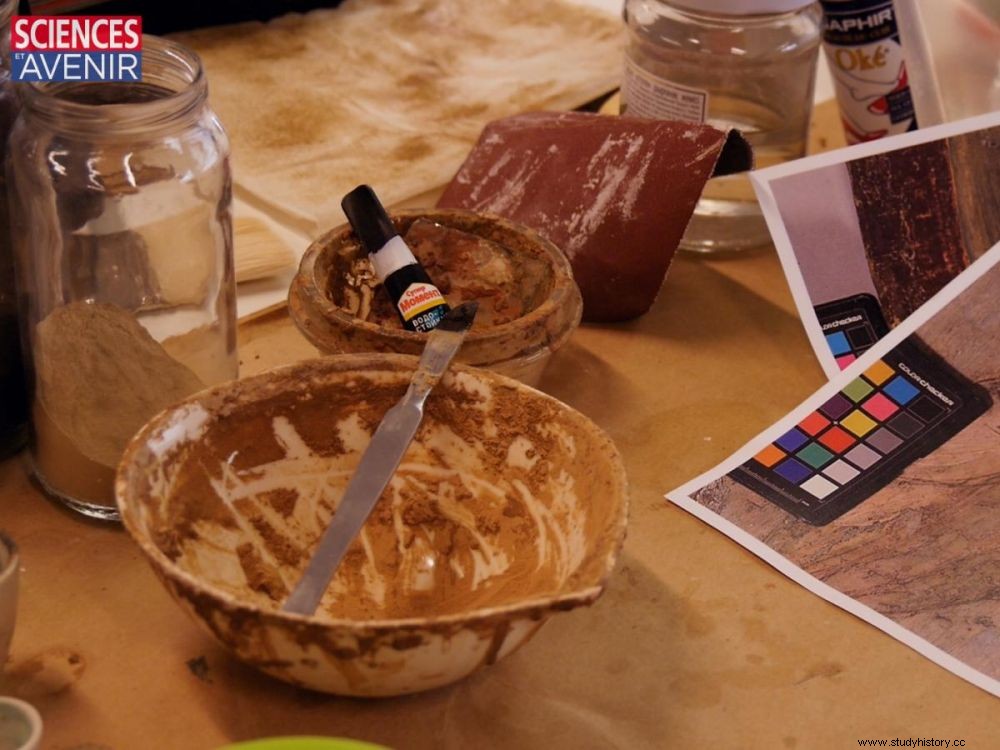Art restorers are peeling the walls of Central Asia to recover the centuries-old paintings that adorn them. Destination:Saint-Petersburg, for a small toilet in their workshops. An "in-house" technique cultivated and perfected since the 1940s, within the Hermitage Museum.

From Oriental murals to Italian Renaissance paintings, the art restorers at the Hermitage Museum in St. Petersburg, Russia, excel in grooming delicate works.
"This is a wall! " smiles Olga Khakhanova behind her blue lock. At the Laboratory for the Scientific Restoration of Mural Paintings at the Hermitage Museum in Saint Petersburg (Russia), she shows with her brush a thin film of clay, placed on a table. A wall ... or rather the pigmentary layer on its surface, alternating ocher and red patterns. Barely a few millimeters, held together by a glued gauze on the back. "This work, like most of those you see here, is a Sogdian painting ", explains the researcher. Sogdiana being an ancient region of Central Asia, straddling present-day Uzbekistan, Tajikistan and Afghanistan. Little known to the general public, the Sogdians nevertheless played an essential role in world trade from the 4th to the 8th centuries. century on the Silk Road, at the gates of India and China.
"This type of painting is absolutely unique in the world and has great scientific value , enthuses the restorer, a specialist in monumental works like this one. A careful look reveals that the painters suggested volume by thickening or thinning the contours of the figures. The proportions of the human characters are also quite original. I find that very impressive."
"This is a wall! " smiles Olga Khakhanova behind her blue lock. At the Laboratory for the Scientific Restoration of Mural Paintings at the Hermitage Museum in Saint Petersburg (Russia), she shows with her brush a thin film of clay, placed on a table. A wall ... or rather the pigmentary layer on its surface, alternating ocher and red patterns. Barely a few millimeters, held together by a glued gauze on the back. "This work, like most of those you see here, is a Sogdian painting ", explains the researcher. Sogdiana being an ancient region of Central Asia, straddling present-day Uzbekistan, Tajikistan and Afghanistan. Little known to the general public, the Sogdians nevertheless played an essential role in world trade from the 4th to the 8th centuries. century on the Silk Road, at the gates of India and China.
"This type of painting is absolutely unique in the world and has great scientific value , enthuses the restorer, a specialist in monumental works like this one. A careful look reveals that the painters suggested volume by thickening or thinning the contours of the figures. The proportions of the human characters are also quite original. I find that very impressive." (see our video report below)
Perfect knowledge of Sanskrit painting treatises
"Studies prove that the painters of Soviet Central Asia knew perfectly the old painting treatises and were perfectly masters of the techniques inherited from the Hellenistic world, which they were able to adapt with local means" , commented Nathalie Lapierre in 1990 in a study published in the journal Asian Arts .
After applying a plaster based on loess (a type of clay, of which the floors were composed), straw and sand or gravel and sometimes even bird feathers, the artists of yesteryear painted on the wall a white clay preparation. Then they "penciled" on this surface human figures and (many) animals. Before the final step of drawing the contours, the colors had to be applied:white (gypsum with kaolin or chalk added), black (charcoal), yellow, red (ochres, cinnabar) and blue (lapis lazuli). "Green is very rare in Soviet Central Asian painting , remarked Nathalie Lapierre. This may be due to the denaturation of this pigment over time, but more certainly to the fact that green is not one of the five fundamental colors used by painters, as described in painting treatises ancient Sanskrits."
Original method of preserving works
As impressive as it is, this type of paint deteriorates very quickly once cleared. It has also posed many problems for scientists. It was during an archaeological excavation campaign in Tajikistan at the end of the 1940s that the founder of the laboratory, P.I. Kostrov, had the idea of using a special resin to consolidate the paint on site. This resin, based on polybutylmethacrylate, "is still considered today as the essential material for the consolidation of the loess coating “, detailed Nathalie Lapierre in her study.
The next steps are to apply a protective gauze on the place, to detach the painting from the wall then to lay it face down, to stick a second gauze on the back and to package everything to send it to the laboratory. "The care taken to remove in place and preserve each painted fragment, often with artisanal means, constitutes one of the most interesting, but also the most misunderstood aspects of Soviet archeology despite the abundance of publications in Russian regarding the topic ", commented the French researcher. Since then, this original method of preserving porous surfaces has been perfected and diversified to other types of media:"Russian lime frescoes, ancient works from China, paintings in from Buddhist monasteries, but also painted sculptures, Italian frescoes and even ceramics , lists Olga Khakhanova. For example, the famous Greek vase Regina vasorum has been restored in our workshop!"
